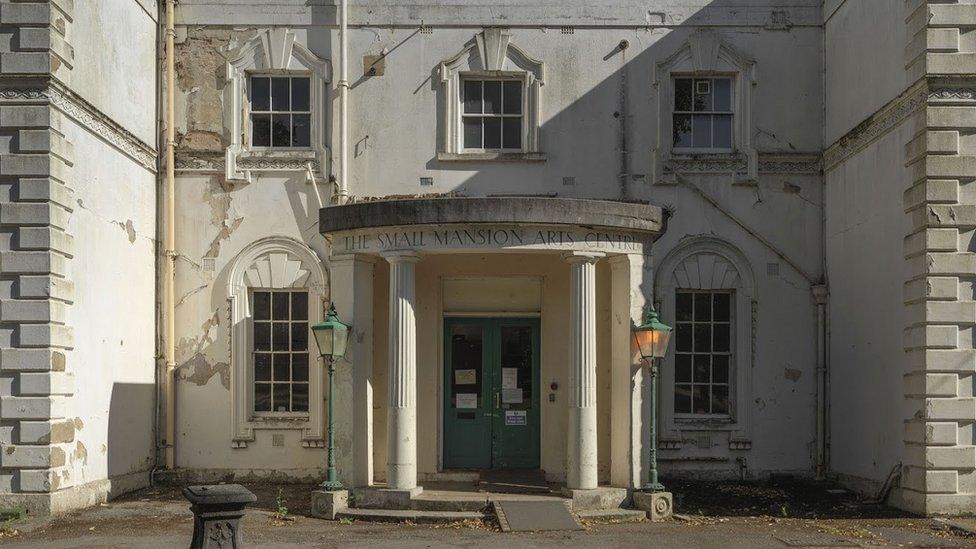Historic England: London sites added to at-risk register
- Published

The Small Mansion in Gunnersbury Park was built in 1802 and while some work has been done on it, the building remains on the register
Seventeen London sites have been added to Historic England's heritage-at-risk register, meaning they could be lost if no action is taken.
A former cinema in Wood Green from the 1930s and a decaying Arts and Craft church in Stamford Hill are among the places included on the annual list.
However, 19 sites have been removed with their futures now considered secure following works taking place.
There are a total of 631 sites in the capital included on the register.
The annual list is created by Historic England to give a snapshot of the state of the country's historic buildings and sites, highlighting those places considered at risk of being lost through neglect, decay or inappropriate development.
Some sites added to register
Former Gaumont Palace Cinema, Wood Green Broadway
This former cinema was designed in the moderne style - a form of architecture which emerged from art deco design
Opening in 1934, this cinema functioned for 50 years, closing in 1984 with Walt Disney's Jungle Book being the last film on show. Subsequently, it has been used as a bingo hall, nightclub and today as a church, the Dominion Centre.
While the central worship area is well looked after, part of the building's façade collapsed in 2018 and it has since been discovered the high-level decorative details have badly corroded.
Brentford Fountain, Brentford
The fountain originally stood near Kew Bridge and was unveiled by a young HRH Princess Mary, Duchess of Teck, in 1877
Brentford Market grew up around this grey granite fountain after it became a focus for traders, but when the market closed in 1974 the fountain was relocated to its current position.
In recent years it has suffered from anti-social behaviour, fly-tipping, and littering, while the lamp standards have been damaged or are missing and it is also not connected to a water supply.
Church of St Bartholomew, Stamford Hill
Completed in 1904, this church was designed by W. D. Caröe who was a major figure in the Arts and Crafts movement
The current building, which replaced a 19th Century church, is in a free Tudor style and has long, low proportions and decorative windows.
Numerous leaks are occurring inside the building with the roof needing urgent attention.
Some sites removed from register
Boston Manor House, Brentford
The manor house has original decorative plaster ceilings and friezes from 1623
Owned by the London Borough of Hounslow, this Jacobean manor house was built in 1623 and extended in 1670.
It has been undergoing a four-year restoration project and is due to reopen to the public next year following significant renovation work to the building.
South Lodge to Grim's Dyke Hotel, Harrow
Only parts of the exterior walls and the chimney stack survived a fire in April 2020
Grim's Dyke Hotel was originally designed as a private residence in 1870-72 for the artist Frederick Goodall and was later owned by writer and librettist W.S. Gilbert, of Gilbert and Sullivan fame.
Its South Lodge was badly damaged by fire in April 2020, leaving only a few exterior walls and the chimney stack, but it has now been reconstructed to how it looked before the blaze.
Hyde Vale Fountain and cattle trough, Greenwich
There are more than 100 listed drinking fountains across London
Situated at the top of Hyde Vale near Ranger's House, this was one of numerous fountains built by Victorian philanthropists to provide free and clean water for the public.
As well as being comprehensively repaired and cleaned, it has also been reconnected to the water supply to again provide safe drinking water to members of the public.
Some sites on the list where "good progress" has been made
Crystal Palace Subway, Bromley
The subway is one of the few remaining parts of the Crystal Palace, which burnt down in 1936
The subway was built in 1865 and is the only surviving element of the famous Crystal Palace, having provided a walkway for visitors who arrived at the Crystal Palace High Level Station.
Since then it has been used occasionally, such as a World War Two air raid shelter and the setting for a music video by The Chemical Brothers, and is now being repaired and restored as a new cultural venue.
Soho Theatre Walthamstow, Walthamstow
Restoration work on the building will be completed in 2023
Constructed between 1929 and 1930, Alfred Hitchcock was a regular of the former EMD/Granada Cinema, while the building also hosted concerts by the likes of The Beatles, Dusty Springfield, The Rolling Stones and Little Richard.
After decades of dereliction, it was acquired by Waltham Forest Council and, once it reopens after restoration work, will be operated as a performance venue by the Soho Theatre Company.
Of the 631 London sites included on the register, 421 are buildings or structural monuments, 101 are places of worship and 12 are parks and gardens.
Some £1.4m in repair grants have been awarded by Historic England to 21 places in the capital, meaning some previously included have been rescued and removed, while "good progress" has been made with others.
Emily Gee, the body's regional director said it was important to "pass on to future generations the rich legacy of historic buildings and places that we have inherited from previous generations".
Follow BBC London on Facebook, external, Twitter , externaland Instagram, external. Send your story ideas to hellobbclondon@bbc.co.uk, external
- Published20 October 2022
- Published12 January 2022
- Published5 July 2022
- Published29 June 2022